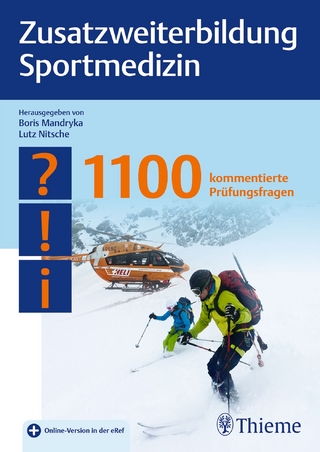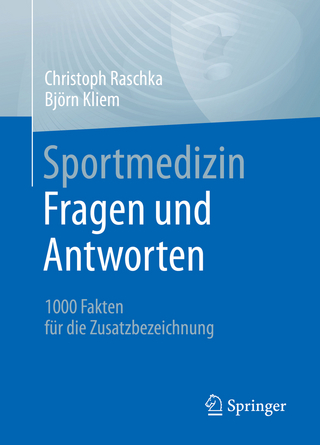
Translational Sports Medicine
Academic Press Inc (Verlag)
978-0-323-91259-4 (ISBN)
In short, this practical guidebook will be of interest to every medical researcher or sports medicine clinician who has ever had a good clinical idea but not the knowledge of how to test it. Readers will come to fully understand important concepts, including case-control study, prospective cohort study, randomized trial and reliability study. Medical researchers will benefit from greater confidence in their ability to initiate and execute their own investigations, avoid common pitfalls in translational sports medicine, and know what is needed in collaboration.
Jeff Bakal PhD, P.Stat. is the Program Director for Provincial Research Data Services at Alberta Health Services which operates the Alberta Strategy for Patient Oriented Research (SPOR) data platform and Health Service Statistical & Analytics Methods teams. He has over 10 years of experience working with Health Services data and Randomized Clinical Trials. He completed his PhD jointly with the Department of Mathematics and Statistics and the School of Physical Health and Education at Queen's University. He has worked on the methodology and analysis of several international studies in business strategy, ophthalmology, cardiology, geriatric medicine and the analysis of kinematic data resulting in several peer reviewed articles and conference presentations. His current interests are in developing statistical methodology for time-to-event data and the development of classification tools to assist in patient decision making processes. Steven DeFroda currently works as a sports medicine fellow at Rush University Medical Center. Steven does research in Orthopedic Surgery, with specific interest in athletic injuries of the knee, shoulder, and elbow. Specific interests include clinical and functional outcomes, biomechanics, and patient quality of life. Dr. Owens is a fellowship-trained, board certified orthopedic sports medicine surgeon, specializing in arthroscopic repair of sports-related injuries as well as complex knee and shoulder reconstructions. He is Chief of Sports Medicine at the Miriam Hospital in Providence, RI and Director of the Rhode Island Cartilage Repair Center. He is Professor of Orthopaedic Surgery at Brown University Alpert Medical School. He is currently a Team Physician for Brown University and the Providence Bruins. He serves as a consultant for URI Athletics. Dr. Owens was named by fellow orthopedists in Orthopedics This Week as one of the “Top 28 North American Knee Surgeons. He has published over 200 articles in peer-reviewed medical journals, given over 200 national or international presentations, co-edited three textbooks on orthopedic injuries, and serves as Associate Editor for the American Journal of Sports Medicine. His research has garnered awards from the American Orthopedic Society for Sports Medicine. Adam E. M. Eltorai, MD, PhD completed his graduate studies in Biomedical Engineering and Biotechnology along with his medical degree from Brown University. His work has spanned the translational spectrum with a focus on medical technology innovation and development. Dr. Eltorai has published numerous articles and books.
INTRODUCTION 1. Introduction 2. Translational Process 3. Scientific Method 4. Basic Research
PRE-CLINICAL 5. Overview of preclinical research 6. What Problem Are You Solving? 7. Types of Interventions 8. Beyond Drugs and Surgery: A Look at Orthobiologics 9. Drug Testing 10. Device Discovery and Prototyping 11. Device Testing 12. Diagnostic Discovery 13. Diagnostic Testing 14. Preclinical: discussion of FDA product categories (what the FDA covers, regulated or not) 15. Procedural Technique Development 16. Behavioral Intervention studies 17. Artificial Intelligence
CLINICAL: FUNDAMENTALS 18. Introduction to Clinical Research: What is it? Why is it Needed? 19. The Question: Types of Research question and How to Develop Them 20. Study Population: Who and Why Them? 21. Outcome Measurements: What data is being Collected and Why? 22. Optimizing the Question: Balancing Significance and Feasibility
STATISTICAL PRINCIPLES 23. Common Issues in Analysis 24. Basic Statistical Principles 25. Distribution 26. Research hypotheses and Error Types 27. Power 28. Multivariable regression models 29. How to choose appropriate bivariate test 30. Categorical Variable Analyses: Chi-square, Fisher exact, Mantel-Haenszel 31. Analysis of Variance: ANOVA 32. Correlation 33. Statistical bias 34. Basic Science Statistics 35. Sample Size 36. Statistical Software
CLINICAL: STUDY TYPES 37. Design Principles: Hierarchy of Study Types 38. Case Series: Design, Measures, and an Example 39. Case-control Study 40. Cohort Studies 41. Cross-section Study 42. Longitudinal Study: Design, Measures, Classic Example 43. Meta-analysis 44. Cost-effectiveness Study: Design, Measures, Classic Example 45. Diagnostic Test Evaluation: Design, Measures, Classic Example 46. Reliability Study: Design, Measures, Classic Example 47. Database Types and Basic Data Management Design Principles for Healthcare Research 48. Survey Studies and Questionnaires 49. Qualitative Methods and Mixed Methods
CLINICAL: TRIALS 50. Randomized and Controlled Trials 51. Nonrandomized Controlled Trials 52. Historical Control: Design, Measures, Classic Example 53. Cross-over Studies 54. Withdrawal Studies: Design, Measures, Classic Example 55. Factorial Design: Design, Measures, Classic Example 56. Group or Cluster Controlled Trials: Design, Measures, Classic Example 57. Hybrid Design: Design, Measures, Classic Example 58. Large, Pragmatic: Clinical Trials 59. Equivalence and Noninferiority: Design, Measures, Classic Example 60. Adaptive Design Measures 61. Randomization: Fixed or Adaptive Procedures 62. Blinding: Who, When, and and How? 63. Multicenter Consideration 64. Phase 0 Trials: Window of Opportunity 65. Registries 66. Phases of Clinical Trials 67. IDEAL Framework
CLINICAL PREPARATION 68. Patient Perspectives 69. Budgeting 70. Ethics and Review Boards 71. Regulatory Considerations for Sports Medicine Technologies: New Drugs and Medical Devices 72. Funding Approaches 73. Conflicts of Interest 74. Subject Recruitment 75. Data Management 76. A Practical Guide to Conducting Research in the Acute Setting 77. Special Populatoins 78. Subject Adherence 79. Time-to-Event Outcomes and Survival Analysis 80. Monitoring Committee in Clinical Trials REGULATORY BASICS 81. FDA Overview 82. Investigational New Drug (IND) Application 83. New Drug Application 84. Medical Devices 85. Radiation-emitting Electronic Products 86. Orphan Drugs 87. Biological Drugs 88. Combination Products 89. Cosmetics in Sports Medicine 90. CMC and GxP 91. Non-US Regulatory 92. Post-Market Drug Safety Monitoring 93. Post-Market Device Safety Monitoring
CLINICAL IMPLEMENTATION 94. Implementation Research 95. Design and Analysis 96. Mixed-methods Research 97. Implementation of Multimodal Concussion Research Within Military Medical Environments 98. Guideline Development
PUBLIC HEALTH 99. Public Health 100. Edpidemiology of Sports Injuries 101. Factors 102. Good Questions 103. Population and Environmental Specific Considerations 104. Law, Policy, and Ethics 105. Healthcare Institutions and Systems 106. Public Health Institutions and Systems
PRACTICAL RESOURCES 107. Presenting Data 108. Manuscript Preparation 109. Promoting Research 110. Quality Improvement 111. Team Science and Building a Team 112. Types of Intellectual Property 113. Venture Pathways 114. Utilizing National Institutes of Health (NIH) Grants to Fund Translational Research 115. Sample Forms and Templates
| Erscheinungsdatum | 26.08.2023 |
|---|---|
| Reihe/Serie | Handbook for Designing and Conducting Clinical and Translational Research |
| Verlagsort | Oxford |
| Sprache | englisch |
| Maße | 216 x 276 mm |
| Gewicht | 1860 g |
| Themenwelt | Medizin / Pharmazie ► Medizinische Fachgebiete ► Sportmedizin |
| Naturwissenschaften ► Biologie | |
| ISBN-10 | 0-323-91259-1 / 0323912591 |
| ISBN-13 | 978-0-323-91259-4 / 9780323912594 |
| Zustand | Neuware |
| Informationen gemäß Produktsicherheitsverordnung (GPSR) | |
| Haben Sie eine Frage zum Produkt? |
aus dem Bereich


